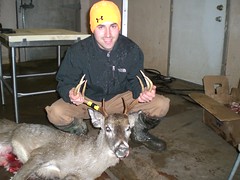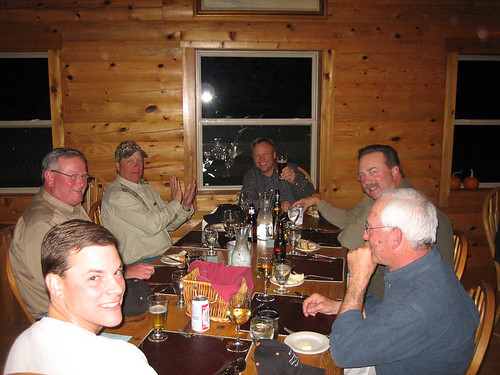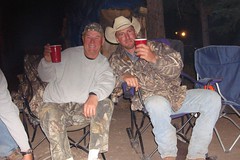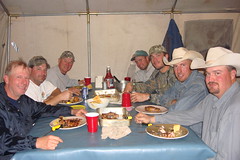Monthly Archives: August 2011
Trophy Gallery
I’ve been having visions of Julian Yates wandering around the Scottish highlands ever since he gave his lecture on SheepTracks at the GWMEMSI conference on objects and ethics. But I’ve also been preoccupied with a more visceral set of animal traces, seduced as I was by Karl Steel and Rob Wakeman’s (and a bunch of other smart people’s) evolving discussion on the consumption of animals (and/or people). I want to think through some of the social forces that make hunting what it is, and I think photography, in the age of the digital camera, may be one of the most interesting ways to approach the topic. So with my trusty steed, Flickr, I set out to find some photos of hunters.
Safety in Numbers
The most common type of hunting photo (at least based on a cursory survey of the material) is a portrait of the hunter with the animal that he or she has recently killed. “First deer down!” by Josh Hicks is a good example.
The image serves as an index of the hunter’s accomplishment. The deer, while dead, is intact, and the hunter physically engages with its dead body to produce a satisfactory photographic composition: both the hunter and the dead deer directly face the camera. In the background, the high horizon line reveals a landscape of dried grasslands and a few leafless trees. Overall it is a remarkably descriptive, even journalistic image: it shows us the hunter, the hunted, the weapon, the landscape, the season, the time of day. It is also a kind of visual erasure of the violence inherent in hunting. Only a hint of blood is visible on the blades of grass in the foreground in the bottom left corner of the photo. This is not a photo of a process, but rather a photo of a state: the success of the hunter and the failure of the hunted. Not narrative (nowhere do we see the dynamic kill of Ashurnasirpal II), but rather consequence is the primary message of the photo. It is the quiet after the storm.
The photographer relies on a set of well-developed, pre-established formal criteria and his or her personal touch is subsumed by them. At Buckpole.net there’s even a short guide for making hunting photos, which is worth excerpting at length:
Hunting Pictures
For the ideal deer hunting pictures there are several things to keep in mind. First it is a recording of an event you are proud of and you may never get a chance to re-take the photo. Commit a few extra moments to make it a great deer hunting picture. Lighting – Make sure there is plenty of light. Too many deer pictures are taken at the end of a hunting day with only the cameras flash as a light source. Get plenty of light on the subject. Most mule deer and whitetail deer blend in with their surroundings, so make sure the background doesn’t blend in with your trophy. Feature the deer first, then the hunter. Position the deer so your hands and arms of the hunter don’t block the view of the deer. If you include the rifle or bow make sure they don’t block the view of the deer. The best deer photos feature the deer!
Interesting Deer Pictures
You can add a interest to the deer hunting picture if you add related items to the picture. Include the deer hunting rifle or bow. Make sure there are elements in the picture of known sizes so one can see just how big your trophy deer is. When possible include a view of the hunt area in the background. These elements add interest and perspective to your deer picture.
The internet is littered with galleries of photos structured exactly like this one, sometimes called trophy galleries. Variations in the age(s), gender(s), and feature(s) of the hunter(s), as well as in the season, time of day, and landscape make each photo unique, but together they possess a kind of cumulative power that suggests something profound is at work in these deceptively simple images. This is particularly evident at sites like Buckpole.net where you are invited not only to contemplate the photos but also to “Rate this rack!” There is a curious conflation of hunter and trophy. To rate the animal is somehow also to rate the hunter.
Not everyone brings a camera with them on the hunt, so photos of deer back at the house are also common. These are usually taken in a garage, the transitional zone between interior/culture/clean and exterior/nature/dirty. Cleanliness becomes a concern not only because of the precarious boundaries between interior and exterior, but also because the animals have already been field dressed.
The Photographer as Hunter
Some images exhibit significantly more photographic skill. “Caught in the decoys” by bigbuzzhunt relies on a shallow depth of field to focus attention on the hunter, who is not proudly displaying his trophy but instead peering into the distance, searching for his target.
The reflection of the sky on the water is distorted by crystals of ice that have formed on the surface, and duck decoys stand in for the missing prey. While the photo foregrounds the process of hunting, it also subtly foregrounds the process of image-making. The light halo around the decoy on the right, for example, is characteristic of dodging and burning in Photoshop or a similar program. Even the quality of the photographic equipment is in a different league. From EXIF data we learn that the photo was made using a high-end digital SLR (in this case, a Canon EOS 5D Mark II). The care that has gone into capturing a visually interesting composition parallels the care with which the subject hunts his prey, and the parallel between hunting and photography (both of which are climactically centered on shooting) may even allow for a reading of the image as self-portrait.
Strange Alliances
It is not the relationship between hunter and hunted that comes to the fore in “Meet n greet” by Bigbuzzhunt, but rather the strange alliances that hunters form with certain animals to the detriment of others.
Perhaps even more startling is the complete removal of the human, both as hunter and as photographer, in images like “Looking good” by Hunterkenyon1. Photos of animals produced by motion-triggered cameras (trail cams) create a closed circuit between technology and nature (as troublesome as those two categories are) from which the human is excluded.
Images like “Looking good” seems to have as much to do with hunting as they do with the work of Kohei Yoshiyuki. Yoshiyuki spent months with the voyeurs of Tokyo’s public parks before producing a series of photos using an infra-red flash that document both the voyeurs and the couples that they hunt.
As Philip Gefter wrote, “Mr. Yoshiyuki’s pictures do not incite desire so much as document the act of lusting.” The motion-activated cameras that document potential prey for hunters raise the question of how technology and the boundaries between species inflect the act of lusting. But let’s resist getting sucked into the vortex of post-humanist desire for a moment.
Map/Reducing Social Networks
The set of practices that hunting entails produces relationships not only between a hunter and his or her trophy, but also between what can (somewhat awkwardly) be referred to as co-hunters. It is an activity that isolates a group of friends, family, and/or co-workers, and allows them to establish or refine modes of interacting with each other through sets of oppositions, both internalized and externalized. Sometimes these connections sneak into trophy photos.
“Bro-skies and the Bull” is especially interesting because it is one of only two images in ktylerski’s flickr account. Sharing the image online was important enough to merit the creation an account in what appears retrospectively to have functioned as a disposable media outlet.
More often than not, however, the combination of socializing and hunting produces a distinct subgenre of images.
I’m afraid this is the kind of thing archaeologists would refer to as “feasting” if the topic were ancient Greece or medieval France instead of contemporary Wyoming. But it appears it is sometimes as important to document the social interactions that accompany hunting as it is to document the individual hunter’s engagement with nature qua prey or the landscape.
Politicized Practices and Bodies
Finally, these photos implicitly image the politicization and regulation of both the “natural environment” and the act of hunting that is made explicit in David Hiser’s photos of a game check station taken as part of the Documerica project in the 1970s.
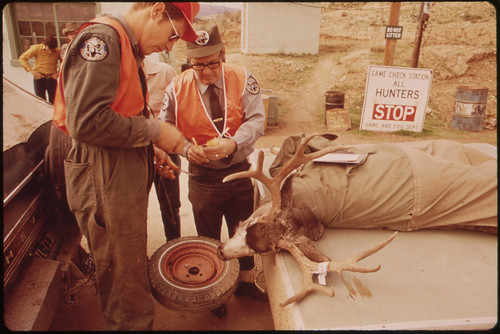
"Deer Hunters' Kill Is Counted and Examined at Check Station North of Rifle by Employees of the Colorado Department of Fish and Game. the Information Is Used to Determine the Time and Duration of Next Year's Season and What Type of Deer May Be Hunted, 10/1972" by David Hiser
I think each of these subgenres merits further investigation. But these images are also responding to a certain set of social demands as they produce genders, humans, animals, and networks. I realize it’s a temporal cross-section, and I want to push this line of inquiry back to see how it holds up over time. How and why does the visual equilibrium between the hunter, the hunted, the social, and the artist change over time?
The doe of the hunt, to whom is she lawful?
At the moment, I’m working on an abstract for a paper for the upcoming Bryn Mawr Graduate Student Symposium Feed Your Head: Food as Material and Metaphor. My tentative topic is the hunting motifs from the wall-paintings of Qusayr ‘Amra, so I’m getting my feet wet with some hunting in pre-/early-Islamic Arabic literature. This is a sketchy collage at the moment but it’s making me start to think about the strangeness of a hunting-desiring/bathing network and how these forces come together to produce an idealized masculinity in which one is precisely not that which one eats (here I’m stuck on the question of alterity and consumption raised in the Derrida interview that Karl Steel linked to a while ago). With that said, some lines of flight:
Idealized masculinity is closely bound up with hunting prowess. The skilled hunter out-lions the lion.
The approved consumption of some foods and the prohibition of others is one of the easier ways to create a collective identity, and the manner of death raises concerns of contamination:
Prohibited to you are dead animals, blood, the flesh of swine, and that which has been dedicated to other than Allah , and [those animals] killed by strangling or by a violent blow or by a head-long fall or by the goring of horns, and those from which a wild animal has eaten, except what you [are able to] slaughter [before its death], and those which are sacrificed on stone altars, and [prohibited is] that you seek decision through divining arrows. Qur’an 5:3
In the pre-Islamic poetry, we get the cliché of the forbidden beloved as prey
Oh, how wonderful is the beauty of the doe of the hunt, to whom is she lawful? To me she is unlawful; would to God that she was not unlawful. The Poem of Antar
but even more intriguing is this visceral description of animal consumption qua courtship
On that day I killed my riding camel for food for the maidens:
How merry was their dividing my camel's trappings to be carried on
their camels.
It is a wonder, a riddle, that the camel being saddled was yet
unsaddled!
A wonder also was the slaughterer, so heedless of self in his
costly gift!
Then the maidens commenced throwing the camel's flesh into the
kettle;
The fat was woven with the lean like loose fringes of white
twisted silk.
The Poem of Imru-ul-Quais



